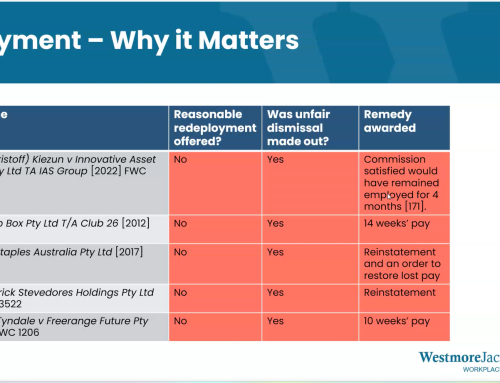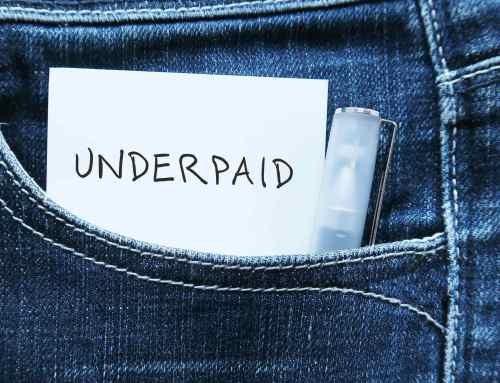
COVID-19 has proved to be a stubborn thorn in the side of Australia’s economic recovery. Thus, it has been necessary for the Federal Government to extend its economic support past the original end date of 27 September 2020.
On 1 September 2020, the Government passed the Coronavirus Economic Response Package (JobKeeper Payments) Amendment Bill 2020. This amendment extends JobKeeper payments and related industrial powers until 28 March 2021, while phasing some features down or out. The Government has also changed eligibility assessment dates to ensure more businesses and employees are eligible for JobKeeper payments.
This article details a number of changes with JobKeeper 2.0 of which employers should be aware.
Phasing down of JobKeeper payments
Although we are still awaiting changes to the Coronavirus Economic Response Package (Payments and Benefits) Rules to reflect this, the Government has announced its intention to reduce the amount of the JobKeeper payments progressively from 28 September 2020, when JobKeeper was initially due to expire.
JobKeeper payments will also no longer remain a flat $1,500 fortnightly payment regardless of hours worked. The Government is introducing 2 tiers of JobKeeper rates. Tier 1 payments will apply to eligible employees who worked 20 hours or more per week on average in the four weeks of pay periods before either 1 March 2020 or 1 July 2020. Tier 2 payments apply to other employees, namely those who worked less than 20 hours per week on average.
From 28 September 2020, the tier 1 rate will drop to $1,200 per fortnight, and from 4 January 2021, it will further reduce to $1,000 per fortnight. The tier 2 rate of $750 per fortnight will be introduced from 28 September 2020, which will further reduce to $650 per fortnight from 4 January 2021.
New employee eligibility reference date
On 14 August 2020, the Coronavirus Economic Response Package (Payments and Benefits) Amendment Rules No. 7 (2020) was made. The amended rules changed the date on which an employee must be employed in order to be eligible to receive JobKeeper payments from 1 March 2020 to 1 July 2020. This means that people who commenced employment with a JobKeeper-eligible business after 1 March 2020, but before 1 July 2020, will now be eligible for nomination for JobKeeper. This change will also mean that more casual employees will be eligible for JobKeeper, as some may now meet the 12 months of regular and systematic employment eligibility criteria.
The date for assessment of eligibility based on minimum age and Australian residency or visa status has also been changed from 1 March 2020 to 1 July 2020.
The amendments ensure that individuals who were eligible under the previous 1 March 2020 assessment date will not lose access to JobKeeper regardless of any changes in their circumstances which would make them ineligible based on the 1 July 2020 test date. For example, if an employee ceased employment after 1 March 2020 and was re-hired after 1 July 2020, their eligibility for JobKeeper payments would recommence from the fortnight in which they were re-hired.
Extension and changes to JobKeeper industrial flexibilities
Existing industrial powers introduced by JobKeeper, including the ability for JobKeeper employers to issue JobKeeper-enabling directions (“JEDs”) to employees, will remain in force until 28 March 2021. The only exception is that the flexibility provisions relating to paid annual leave, such as those allowing employers and employees to make an agreement in relation to the taking of annual leave, will not be extended past 27 September 2020.
More notably, the ability to issue JEDs has been extended to employers that previously received JobKeeper payments but do not re-qualify under the new eligibility rules from 28 September 2020 onwards. These employers are referred to as “legacy employers”. They can still continue to issue JEDs if they can demonstrate a 10% decline in current GST turnover in the relevant quarter compared to the same quarter the previous year. Businesses that satisfy this requirement should obtain a “10% decline in turnover certificate” from an eligible financial service provider, unless they are a small business employer in which case a statutory declaration is sufficient.
The JEDs that legacy employers can issue are set out in the new Division 5A of Part 6‑4C of the Fair Work Act 2009 (Cth) (“FW Act”). They largely mirror the JEDs available to businesses in receipt of JobKeeper payments, save for the following notable exceptions:
- A JED cannot require an employee to work less than 2 hours on a day that they work;
- Reductions to an employee’s hours of work cannot be below 60% of that employee’s ordinary hours of work, assessed as at 1 March 2020; and
- Employers must give employees seven days’ written notice before issuing a JED (as opposed to the three day notice period that applies to other JobKeeper employers).
The Government has also introduced provisions which prohibit legacy employers purporting to issue JEDs if they do not satisfy the 10% decline in turnover test, or making a false statutory declaration concerning whether they satisfy the test. Civil penalties apply to those who do.
Directions may also be terminated by the Federal Court where the employer does not satisfy the 10% decline in turnover test.
More guidance on “unreasonable in all the circumstances”
Under s789GK of the FW Act, a JED does not apply to an employee if the direction is unreasonable in all the circumstances. A note has been added to this section. It says that directions which reduce hours for a category of employees may be unreasonable if they have an unfair effect on some employees compared to other employees in the same category who are also subject to those directions.
This note appears to support recent decisions which have emphasised the need for employers to consider any disproportionate unfair effects of a JED on reducing an employee’s hours such as Wilfred Lam v Mobile Technology International Pty Ltd
Conclusion
New changes to employee eligibility rules, and the extension of JobKeeper industrial powers to businesses no longer eligible for JobKeeper payments, may provide some relief to employers as JobKeeper payments are phased out.
However, employers should ensure they understand how JobKeeper 2.0 will affect them. Employers should be mindful of these changes and seek advice as required.
Adam Colquhoun, Principal
This article is general information only. It is not legal advice. If you need legal advice, please contact us.





